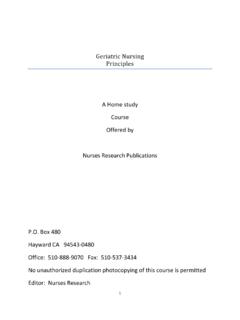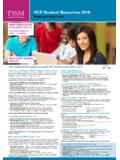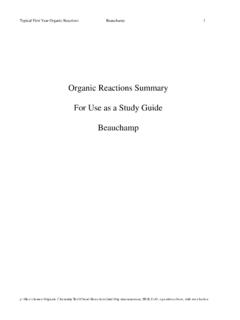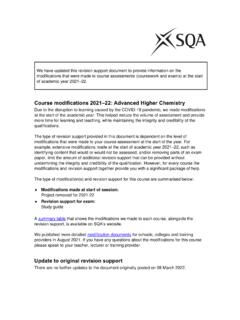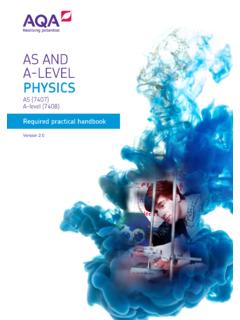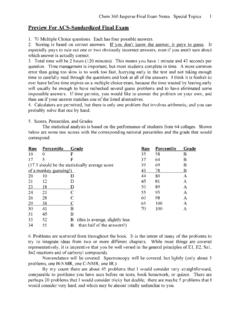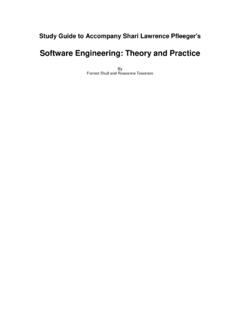Transcription of Laboratory Tests Interpretation - Nurses Learning
1 Laboratory Tests Interpretation By Nurses REASEARCH PUBLICATION Continuing Education 2001 ALL RIGHTS RIGHTS RESERVED. No part of this material may be reprinted, reproduced, transmitted, stored in a retrieval system, or otherwise utilized, in any form or by any means electronic or mechanical, including photocopying or recording, now existing or hereinafter invented, nor may any part of this course be copied and used for any other purpose without the written permission from the publisher and author. For low-cost copies, contact Nurses RESEARCH PUBLICATION 510-888-9070 Reprint Division. Notice and Disclaimers: Medicine and Nursing are ever-changing sciences. As new information is gained, changes in treatments and drug therapies are required. The author(s), editor, and publisher of this text have used every possible reliable source in order to verify information in this text, to be sure that the information is accurate and the most current and acceptable information available at the time of publication.
2 However, due to human error and/or changes in medical science, neither the editors nor publishers nor any other parties involved in the preparation or publication of this text, warrant that the information contained herein is in every respect accurate or complete, and they are not responsible for any errors or omissions or for the results obtained from use of such information. Readers are encouraged to confirm the information contained herein with other sources. For example, and in particular, readers should check the product information sheet for any drugs mentioned in this text that you plan to administer. This course is designed to provide nursing professionals with general information to assist in their practices and professional development. The information provided in this course is based on research and consultation with medical and nursing authorities, and is, to the best of our knowledge, current and accurate.
3 However, this course is offered with the understanding that Nurses Research Publication is not engaged in rendering legal, nursing, or other professional advice. This course is not a substitute for seeking professional advice or conducting individual research. In applying the information provided in this course to individual circumstances, all recommendations must be considered in light of the unique circumstances of each situation. This course book is intended solely for individual use, and not for the benefit of providing advice or recommendations to third parties. Nurses RESEARCH disclaims any responsibility for any adverse consequences resulting from the failure to seek medical, nursing, or other professional advice, or to conduct independent research. Nurses RESEARCH further disclaims any responsibility for updating or revising any programs or publications presented, published, distributed or sponsored by Nurses RESEARCH unless otherwise agreed to as part of an individual purchase contract.
4 IMPORTANT IMPORTANT -- PLEASE READ THESE INSTRUCTIONS PLEASE READ THESE INSTRUCTIONS 5. 5. Course InstructionsCourse Instructions:: a. PRETEST questions are included at the start of each chapter. Answer these questions before you read the chapter. DO NOT SEND US YOUR PRETEST ANSWERS. These questions are only for the purpose of testing your knowledge base BEFORE you read the course material. b. The POSTTEST or the " final Examination" is included as a separate final EXAM BOOKLET. When you finish reading and studying the ENTIRE COURSE, take the final exam and place answers on the enclosed answer sheet. RETURN ONLY THE ANSWER SHEET TO US, not the final exam booklet. A passing score of 70% is required. If you fail the exam, you will be allowed to take the test again, no charge. Your passing score will be printed on your certificate. 6. 6. License RenewalLicense Renewal:: In California, the RN and LVN State Board requires you to fill out a form with continuing education information in order to renew your license.
5 The Board in California does not normally require a copy of your CEU completion certificate (RN, LVN, LPT), just the information printed on your certificate. Do not send the board certificates unless they specifically ask for a copy. If you should need your certificate rushed, we can FAX a copy for $10 (certificate mailed free). 510-537-3434 TABLE OF CONTENTS Instructions .. 3 Course Outline .. 5 Chapter I Introduction to the course .. 7 Terms and Abbreviations .. 8 Chapter II Collection Techniques.. 13 Chapter III Hematology Studies .. 19 Hematology Studies.. 21 Coagulation Studies .. 31 Chapter IV Special Serology and Blood chemistry Tests .. 35 Blood Chemistry Testing .. 36 Cardiac Enzymes .. 37 Serum electrolytes.. 41 Chapter V Body fluid Lab Tests .. 47 Urinalysis.. 48 Chapter VI Select organ function Tests .. 57 Liver Function Tests .. 58 Chapter VII STD and HIV Blood Tests .
6 65 Laboratory Testing for HIV.. 69 Chapter VIII Arterial Blood Gas Interpretation .. 77 Chapter IX Select Diagnostic Tests .. 91 Histology, Cytology, and Cytogenic Testing.. 92 Nuclear Medicine Procedures .. 99 Electroencephalography..108 References Separate Examination Booklet Course Outline Chapter I Introduction Introduction to course Terms and Abbreviations Chapter II Collection Techniques Chapter III Hematology Blood Tests A Hematology Studies B Coagulation Studies Chapter IV Special Serology and Blood Chemistry Tests A Cardiac Enzymes B Serum Electrolytes C Blood Groups and Blood Transfusions Chapter V Body Fluid Lab Tests A Urinalysis B Cerebrospinal Fluid Examination Chapter VI Select Organ Function Blood Tests A Liver Function Tests B Thyroid Function Tests Chapter VII STD and HIV Lab Tests Chapter VIII Arterial Blood Gas Interpretation Chapter IX Select Diagnostic Tests References Posttest See Separate Examination Booklet Course Objectives Global Course Objectives: At the end of this course, each participant will be able to: 1.
7 Give better patient care due to an enhanced knowledge of Laboratory Tests and the Interpretation of the results of these Tests . 2. perform satisfactorily on an objective examination at the end of this course (70% or better). Specific Behavioral Course Objectives: At the end of this program, each participant will be able to: 1. name and discuss at least 3 lab specimen collection considerations and their nursing implications. 2. name and discuss at least 5 hematology lab Tests and coagulation Tests and their nursing implications. 3. name and discuss at least 2 cardiac enzyme lab Tests and 3 serum electrolyte and blood group Tests and their nursing implications. 4. name and discuss at least 3 components of the urinalysis lab test and describe the nursing implications. 5. name and discuss at least 3 components of the cerebrospinal fluid analysis lab test and the nursing implications. 6.
8 Name and discuss at least 5 components of the liver function lab test and the nursing implications. 7. name and discuss at least 2 components of the thyroid function lab test and the nursing implications. 8. name and discuss at least 2 serological lab Tests and their nursing implications. 9. name and discuss at least 2 lab Tests used to detect HIV antibodies in the blood and 2 additional Tests used to indicate levels of HIV antibodies in the blood and their nursing implications. 10. name and discuss at least four components of the arterial blood gas Interpretation lab test, describing how the test is performed, the results of the test, and the nursing implications of the test. Laboratory Tests Interpretation Nurses RESEARCH 2001 CHAPTER I INTRODUCTION TO THE COURSE Terms and Abbreviations Amniocentesis--is a procedure that includes the insertion of a needle into the suprapubic area after the fetus has been located and manually elevated and the aspiration of 5 to 15 ml of amniotic fluid.
9 Ultrasound may be used to locate the placenta and fetal position so that needle contact may be avoided. Amniocentesis is usually performed from the 14th to 16th week of pregnancy; usually never before the 14th week due to insuffi-cient amounts of amniotic fluid. Anatomic Pathology--This field of pathology deals with structural changes. These changes may be apparent to the examiner with the naked eye, or a microscopic examina-tion may be needed. Blood Bank (Immunohematology)--We all know of the responsibility of the blood bank in obtaining, storing, and dispensing blood for trans-fusions. There are other functions including: obtaining and handling other blood products, some of which are rare; and also research in blood transmitted diseases. Bronchography, Bronchogram--Bronchography is an X-ray examination that visualizes the trachea, bronchi, and the bronchial tree. Clinical Chemistry--This section of the lab performs analyses on whole blood, serum, plasma, urine, and other biological specimens like cerebrospinal fluid, am-niocentesis fluid, pleural fluid, periton-eal fluid, and feces.
10 Clinical Microbiology--This section of the lab is involved with a variety of biological specimens such as: urine, feces, blood, sput-um, CSF, drainage, exudates, nail, skin, tissue, and swabs from throat, wounds, and other such specimens. Clinical Pathology--Clinical pathology refers to the section of the pathology lab which applies to the problem of find-ing solutions to the problems found in the clinical areas. The members of this team in-clude medical tech-nologists, medical scientists, tech-nicians and pathologists. Together they perform Tests and inves-tigations into all aspects of disease, including preven-tion, diagnosis, and treatment. Cytology--Cytology is the study of the individual cells. This department has cytologists and cyto-technologists who are trained to perform prelimi-nary screening on cells. Any of these suspicious cells are then usually examined by the pathologi-st.
